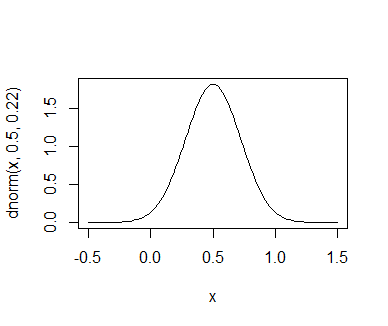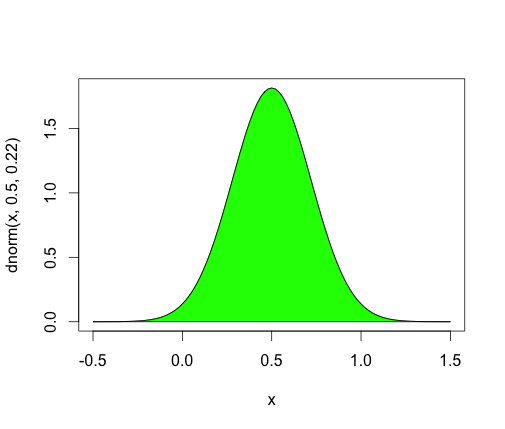有没有一种快速的方法来填充R中的曲线?
有没有一种快速的方法来填充R中的曲线?
提问于 2015-11-25 00:48:55
我熟悉polygon和ggplot2,但我喜欢使用基本plot。
我想填写命令调用的曲线:
curve(dnorm(x, 0.5, 0.22), xlim=c(-0.5, 1.5))

当我在过去使用polygon时,我根据以前按照x <- seq(-0.5, 0.5, len = 100)和y <- dnorm(x, 0.5, 0.22)的思路对x进行的计算定义了端点。接下来,在polygon中定义限制,选择的颜色,等等.在不到两周的时间里,有颜色.
好的,不是很快,但在这个特殊情况下,我甚至没有在x和y之外显式定义curve,这使得整个过程更加繁琐。就像重新开始一样。
是否有任何方法可以快速完成,例如fill、col或curve中的其他绘图参数
Stack Overflow用户
回答已采纳
发布于 2015-11-25 01:01:50
实际上,您可以相对轻松地修改curve函数。我所做的唯一改变是:
1)将默认的fill参数添加到"red“
2)在函数末尾添加一个polygon图(标记为注释)
这是起作用的函数。有关函数代码,请参见下面的内容。
my_curve(dnorm(x, 0.5, 0.22), xlim=c(-0.5, 1.5), fill="green")

我不确定这是否比仅仅这样做更有利:
x=seq(-0.5,1.5,0.01)
plot(x, dnorm(x,0.5,0.22), xlim=c(-0.5,1.5), type="l")
polygon(x, dnorm(x,0.5,0.22), col="green")但是,如果要大量使用它,可以在脚本中使用my_curve,或者使用新版本的curve创建一个包,该包可以屏蔽基本版本。您还可以使fill成为可选的,也许还可以添加允许部分填充的特性。
如果您对ggplot2的默认设置不感兴趣,您也可以去掉它们,同时仍然保留ggplot语法的好处:
library(ggplot2)
df = data.frame(x=seq(-0.5,1.5,0.01), y=dnorm(x,0.5,0.22))
ggplot(df, aes(x,y)) +
geom_area(colour="black", fill="red") +
theme_bw() +
theme(panel.grid=element_blank())下面是修改后的curve函数:
my_curve = function (expr, from = NULL, to = NULL, n = 101, add = FALSE,
type = "l", xname = "x", xlab = xname, ylab = NULL, log = NULL,
xlim = NULL, fill="red", ...)
{
sexpr <- substitute(expr)
if (is.name(sexpr)) {
expr <- call(as.character(sexpr), as.name(xname))
}
else {
if (!((is.call(sexpr) || is.expression(sexpr)) && xname %in%
all.vars(sexpr)))
stop(gettextf("'expr' must be a function, or a call or an expression containing '%s'",
xname), domain = NA)
expr <- sexpr
}
if (dev.cur() == 1L && !identical(add, FALSE)) {
warning("'add' will be ignored as there is no existing plot")
add <- FALSE
}
addF <- identical(add, FALSE)
if (is.null(ylab))
ylab <- deparse(expr)
if (is.null(from) || is.null(to)) {
xl <- if (!is.null(xlim))
xlim
else if (!addF) {
pu <- par("usr")[1L:2L]
if (par("xaxs") == "r")
pu <- extendrange(pu, f = -1/27)
if (par("xlog"))
10^pu
else pu
}
else c(0, 1)
if (is.null(from))
from <- xl[1L]
if (is.null(to))
to <- xl[2L]
}
lg <- if (length(log))
log
else if (!addF && par("xlog"))
"x"
else ""
if (length(lg) == 0)
lg <- ""
if (grepl("x", lg, fixed = TRUE)) {
if (from <= 0 || to <= 0)
stop("'from' and 'to' must be > 0 with log=\"x\"")
x <- exp(seq.int(log(from), log(to), length.out = n))
}
else x <- seq.int(from, to, length.out = n)
ll <- list(x = x)
names(ll) <- xname
y <- eval(expr, envir = ll, enclos = parent.frame())
if (length(y) != length(x))
stop("'expr' did not evaluate to an object of length 'n'")
if (isTRUE(add))
lines(x = x, y = y, type = type, ...)
else plot(x = x, y = y, type = type, xlab = xlab, ylab = ylab,
xlim = xlim, log = lg, ...)
polygon(x,y, col=fill) # Add filled area under curve
invisible(list(x = x, y = y))
}页面原文内容由Stack Overflow提供。腾讯云小微IT领域专用引擎提供翻译支持
原文链接:
https://stackoverflow.com/questions/33906665
复制相关文章
相似问题

